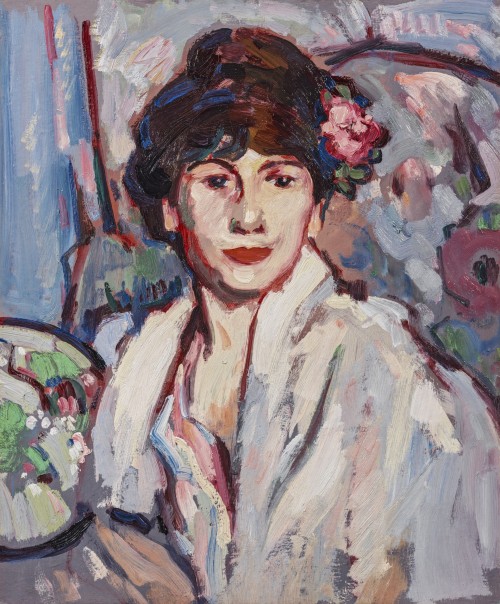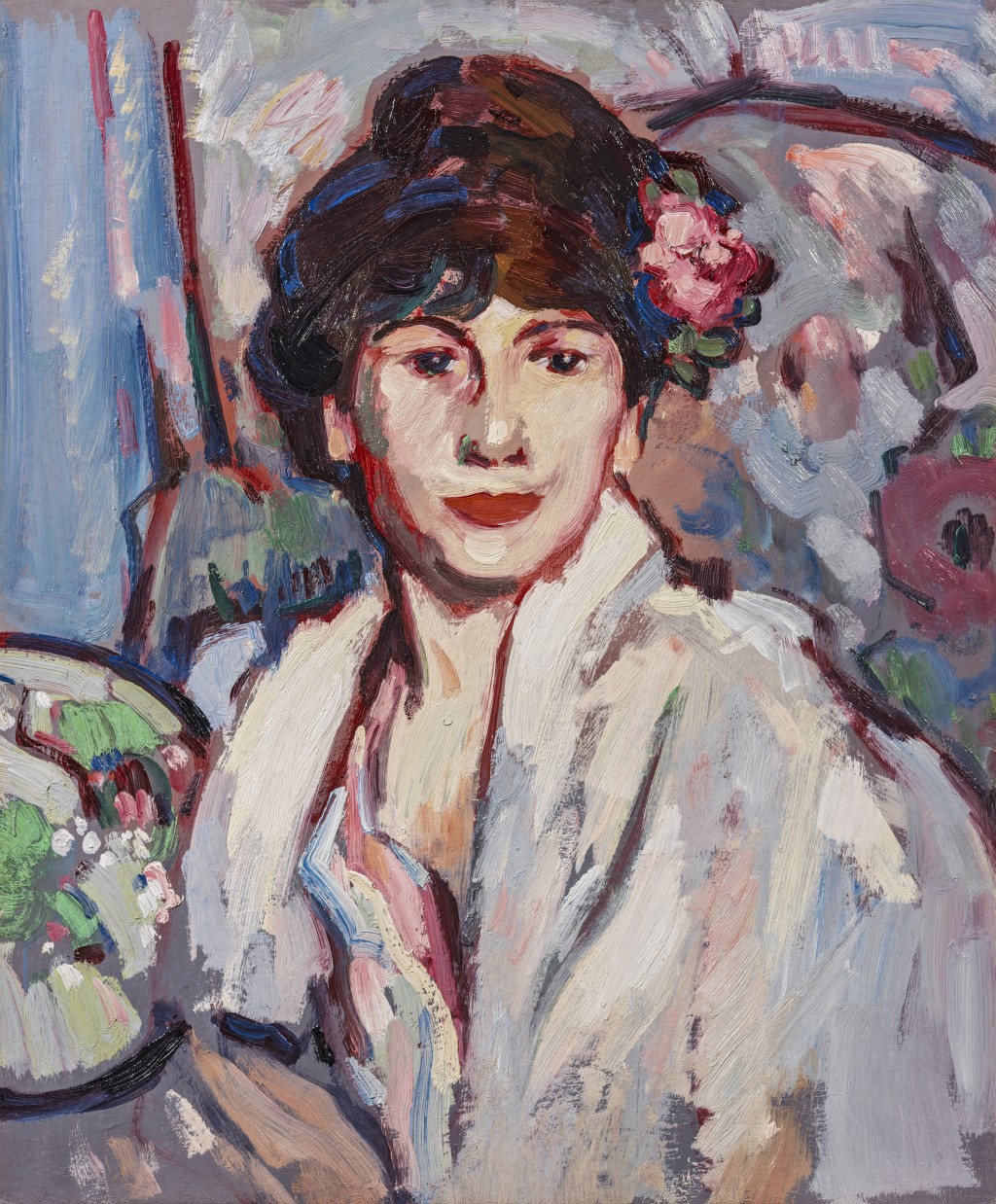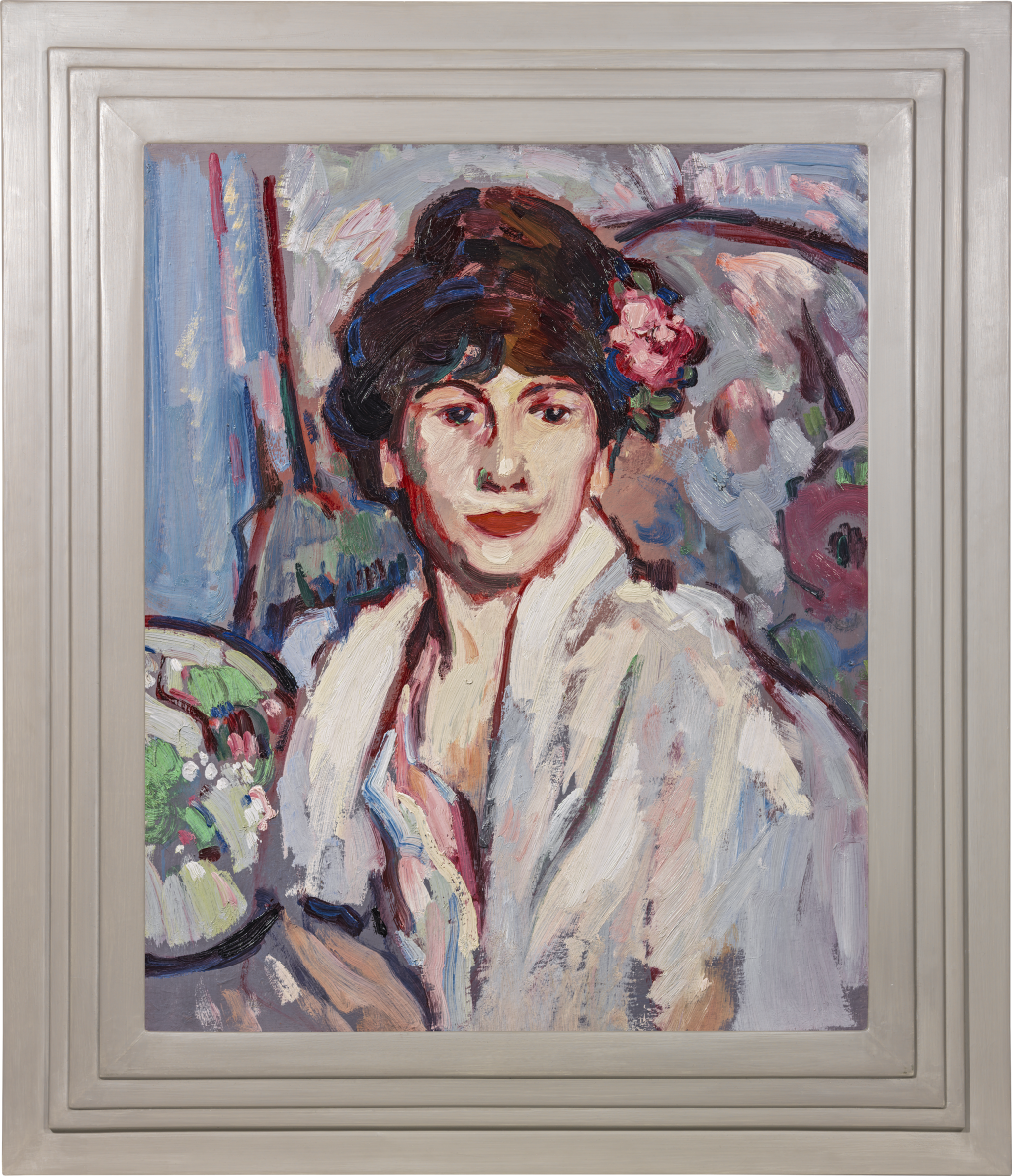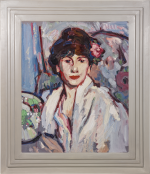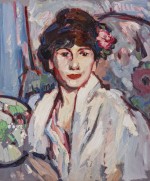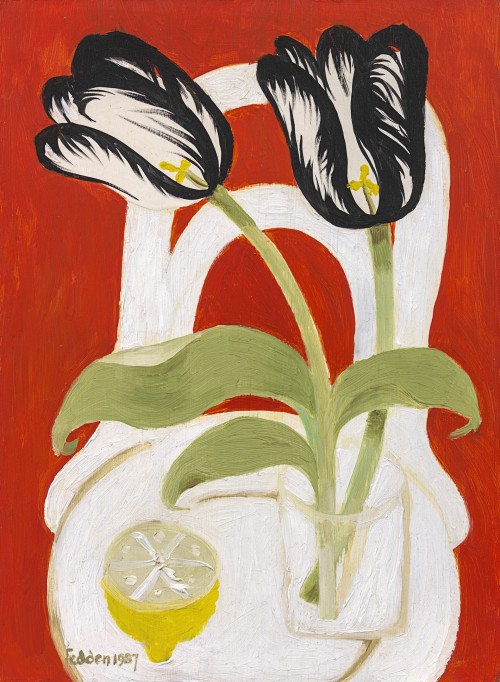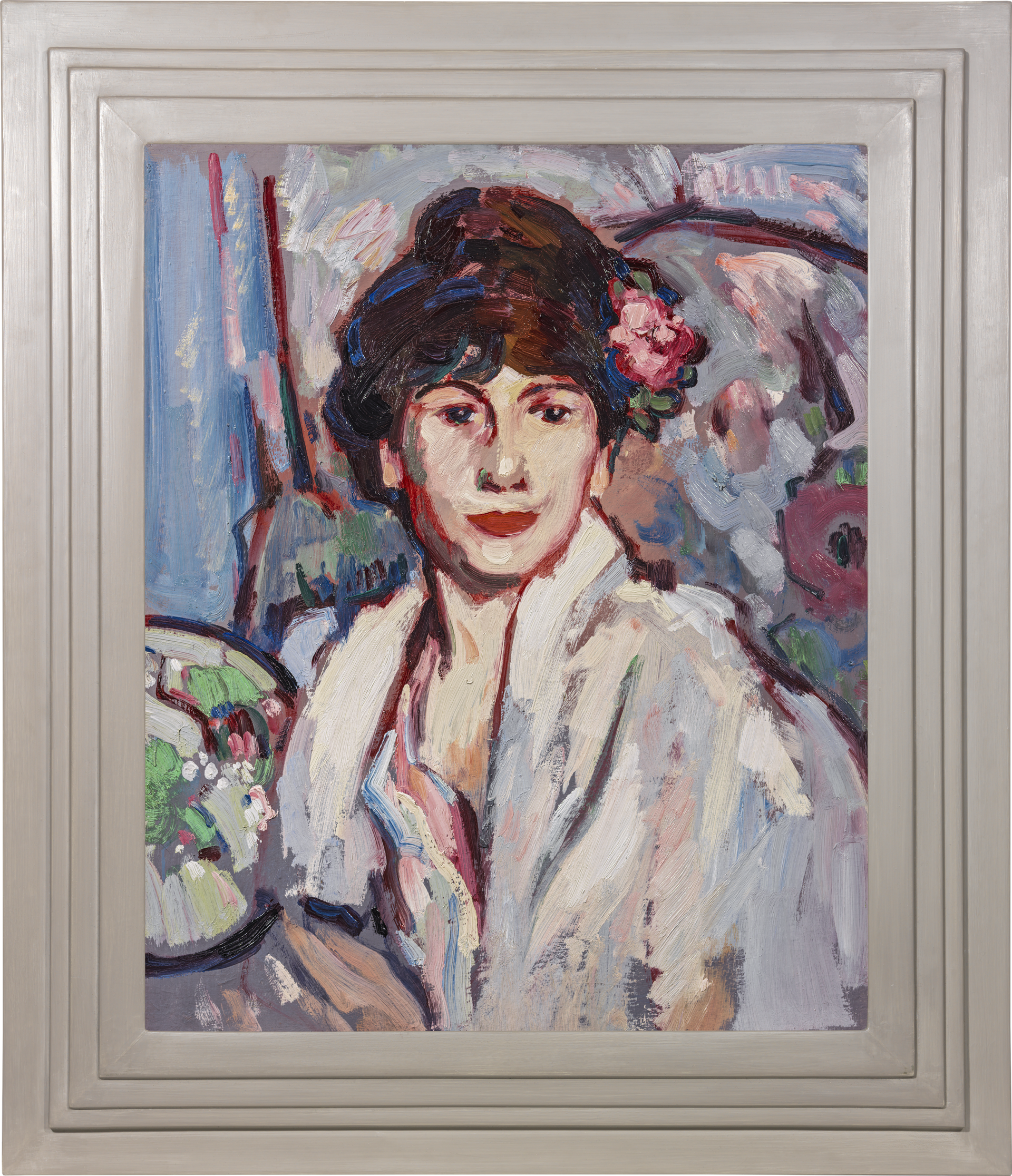JOHN DUNCAN FERGUSSON RBA
Leith 1874 - 1961 Glasgow
Ref: CC 171
Rose in the hair
Signed, dated and inscribed on the reverse: J. D. Fergusson / Paris / 1908. Signed, dated and inscribed again: J. D. Fergusson / no.44 / "Rose in the Hair" / Paris 1908
Oil on board: 25 ¼ x 21 ¼ in / 64.1 x 54 cm
Frame size: 33 ⅜ x 28 ¾ in / 84.8 x 73 cm
In a Gluck style frame
Provenance:
The artist during his lifetime, then by descent to Margaret Morris, the artist’s wife;
Dr Kenneth Ireland OBE (1920-1999), Director of Pitlochry Festival Theatre, acquired from the above in 1966/67, then by descent
Exhibited:
Glasgow, T & R Annan & Sons Ltd., Exhibition of Paintings by John Duncan Fergusson, September-October 1949, no.25
Edinburgh, L’Institut Français d’Ecosse, Paintings of France and Scotland by John Duncan Fergusson, 1st February-10th March 1950, no.21
Edinburgh, Royal Scottish Academy, Arts Council of Great Britain, Scottish Committee, J D Fergusson 1874-1961: Memorial Exhibition of Paintings and Sculpture, 11th November-2nd December 1961, no.39, this exhibition then toured to Glasgow Art Gallery and Museum, 9th December 1961-6th January 1962; Dundee Art Gallery, 13th-27th January 1962; Aberdeen Art Gallery, 3rd-24th February 1962; The Smith Art Gallery, Stirling, 3rd-17th March 1962; Perth Art Gallery, 24th March–7th April 1962; The Towner Art Gallery, Eastbourne, 12th May-2nd June
This charismatic masterpiece, painted by John Duncan Fergusson in 1908 at a pivotal moment in his career, captures the spontaneity and dynamism of modern art in Paris at the dawn of the twentieth century. Fergusson came into contact with many important contemporary painters at this time, including Picasso, but it was Matisse and the artists labelled Les Fauves at the sensational Salon d’Automne of 1905, whose work had the greatest influence on him. Fergusson’s direct involvement in the modern art scene saw him exhibiting alongside the progressive avant-garde at the Salon d’Automne months after moving to Paris in 1907 and just two years later he was elected Sociétaire.
Rose in the hair is most likely a portrait of a kindred spirit and contemporary, Fergusson’s lover and muse, Anne Estelle Rice (1877-1959), as well as a tour de force of stylish and assured femininity. Fergusson met the American artist at Paris-Plage in 1907, their creative and personal relationship lasting six years in pre-war Paris. Rice’s Self-portrait, circa 1909-10 (currently on view at the National Portrait Gallery, Washington, as part of their exhibition, Brilliant Exiles: American Women in Paris 1900-1939) also depicts her looking out at the viewer with flowers in her hair before a decorative, floral setting. Fergusson’s dynamic use of colour applied in bold, expressive strokes with strong outlines and shadows in red, green and blue, echoed in the rose and flat, decorative ground, demonstrates his development of Fauvist portraiture and places him at the forefront of modern art.
A strong, charismatic character, Rice was born in Pennsylvania, completing an art degree in 1897 despite parental disapproval, and worked as an illustrator for publications such as Harper’s Bazaar before being sent to Paris in 1905 by the department store owner, Rodman Wanamaker, to illustrate the latest fashions with her colleague Elizabeth Dryden for The North American.[1] Without mentioning her by name, Margaret Morris records the artists’ meeting in her ‘biased biography’ of Fergusson: ‘She was already a successful book illustrator, but at her art school had been told that she would never become a painter in oils. She was coming to Paris to do sketches of the top dressmakers’ spring collections. Fergus said she must start painting in oils, and that he would make her a first class painter which he did. She rented a studio and for eight years lived and worked in Paris. Her pictures were well hung in big Paris exhibitions and often sold. Later she had success in America and London.’[2]
With their innate artistic flair, sensual response to the world and shared interest in the female form, Rice and Fergusson’s relationship was that of equals, more reciprocal and mutually beneficial than Morris might suggest. Elizabeth Cumming writes that Rice’s established style of drawing for publication, ‘heavily contoured with ‘simplification of interior detail and shading’…began to give Fergusson’s art a more expressionist edge.’[3] Kenneth McConkey suggests that her Danseuses Égyptiennes, hailed at the Salon d’Automne of 1910, ‘may have acted as inspiration for Fergusson’s transition to grand processional friezes like Les Eus.’[4] Rice’s connection with Wannamaker seems to have benefitted Fergusson, who drew a salary to create designs and posters for John Wannamaker’s trade magazine, enabling him to buy new painting materials, and Fergusson later reciprocated by commissioning Rice as Art Editor of the journal Rhythm, 1911-13, to which she contributed an article on the debut of the Ballet Russes as well as several drawings.[5] Rice’s Self-portrait, c.1909-10 (private collection) and mural paintings for the Wannamaker store, commissioned in 1908 (now lost), featured decorative, floral backdrops, as did her portrait of the writer Katherine Mansfield, painted in 1918, Museum of New Zealand.
Fergusson frequently painted Rice between 1907 and 1909 (the majority in public collections),[6] his beguiling depictions of her documenting his stylistic development from belle époque portraiture, in Hat with bird: Anne Estelle Rice (Kelvingrove Art Gallery & Museum, Glasgow), to the broken brushstrokes and bold green shadows of Fauvism, in Anne Estelle Rice, Closerie des Lilas (Hunterian Art Gallery, Glasgow). The dynamic use of colour, bold outlining of form and flat, decorative style characteristic of Fauvist portraiture can also be seen in Rose in the hair.
[1] Carol A Nathanson, ‘Anne Estelle Rice: Theodore Dreiser’s “Ellen Adams Wrynn”, Woman’s Art Journal, Autumn 1992-Winter 1993, vol.13, no.2, pp.3-11. Rice studied at the School of Industrial Art of the Pennsylvania Museum and later at the Pennsylvania Academy of Fine Arts.
[2] Margaret Morris, The art of J.D. Fergusson: a biased biography, op. cit., pp.55-56; ‘This was the life I had always wanted and often talked about. We were a very happy group: Anne Rice, Jo Davidson, Harry and Bill McColl, Yvonne and Louis de Kerstratt, Roffy the poet, La Torrie, mathematician and aviator.’ p.46 from Fergusson’s ‘Memories of Peploe’ in the Scottish Art Review.
[3] Elizabeth Cumming, ‘La vie de Bohème: Fergusson in France’, JD Fergusson, exh. cat. National Galleries of Scotland, Edinburgh, 2013, pp.53-54.
[4] Kenneth McConkey, Edwardian Portraits Images of an Age of Opulence, Antique Collectors’ Club, Woodbridge, 1987, p.216. The Egyptian Dancers, 1910, Brooklyn Museum, New York, hung in the ‘Place d’Honneur’ and caused a sensation, see Alicia Foster, Radical Women: Jessica Dismorr and her contemporaries, Lund Humphries in assoc. with Pallant House Gallery, 2019, p.19.
[5] Oscar Raymond Drey, ‘Anne Estelle Rice’, Anne Estelle Rice 1879-1959: Paintings, exh. cat., University of Hull, 1969.
[6] In works including The green cushion, 1907, Kirkcaldy Galleries; The white ruff, 1907, Perth & Kinross; Anne Estelle Rice, 1908, Scottish National Gallery of Modern Art, Edinburgh.

